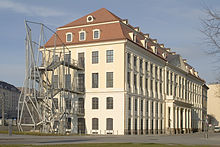- Dresden City Art Gallery
-
The Dresden City Art Gallery (Städtische Galerie Dresden - Kunstsammlung) is the city art collection of Dresden, housed in the city's Landhaus. It was formed by the 19th and 20th century artworks in the Dresden City Museum, split off from the Museum and given a separate display in 2000.[1][2] In 2002 Dr. Gisbert Porstmann became its founding director and in 2005 the City Art Gallery officially opened.
Contents
Location
The Städtische Galerie Dresden is located on the first floor of Dresden's city hall, built in 1770-1775 to designs by the court architect Friedrich August Krubsacius, as a conference building for the Saxon estates. Other Dresden museums nearby are the Dresden Fortress Museum, and the Albertinum Museum.
The Collection began with the founding in 1869 of the Society for the History and Topography of Dresden and its surroundings. Its members gathered evidence both of bourgeois urban culture, and the first paintings. Emphasis was on portraits of important personalities, views the city, and the surrounding landscapes. The fast-growing municipal collection were housed in different buildings, until placed on 1 October 1910, in the rooms around the atrium of the newly built city hall, where they remained until their traveling during the World War II.
Paul Ferdinand Schmidt, who was director from 1919 to 1924, of the municipal collections, began the redesign of the art collection. Schmidt based his purchases of art-historical categories: he bought, works by Erich Heckel, Ernst Ludwig Kirchner, Otto Dix, Oskar Kokoschka, Kurt Schwitters and Lasar Segall, and built up a world-class collection of art of German Expressionism.
During the "Degenerate Art" period, art was seized by the Nazis, including 498 individual works of the municipal art collection. The largest part of the art treasures are still regarded as missing, only a few works were found later in major national and international museums. During the war, and in the immediate postwar period more important works of art lost. A complete inventory and catalog of the loss is in progress.
After the Second World War, the city's art inventory, in the Institute and Museum of the History of Dresden, was moved to the renamed Dresden City Museum in 1990, which is primarily devoted to the exploration of the city's history.
In 2000, the Dresden city council established a municipal art museum. In parallel, on 1 June 2002 they celebrated the founding of the Dresden Municipal Gallery, developed with sponsorships. The Municipal Art Gallery acquired the stock of the Dresden City Museum, and on 2 July 2005, their showrooms on the first floor opened. In the permanent exhibition in the West Wing, are works by painters and sculptors from 19 to the 21st Century. The east wing will hold temporary exhibitions.
On 10 December 2007, the Dresden Municipal Gallery announced a significant increase in their collection. With the acquisition of an extensive collection of works by A. R. Penck (Ralf Winkler) owned by Jürgen Braden, and a generous gift from the collector received the Städtische Galerie Dresden approximately 40 paintings, objects and assemblages, 330 watercolors and drawings, 340 overwriting, 80 graphic works and more than 100 works from the perimeter of the artist group "gap" in the AR Penck leading scientists.
Edition
At its opening, of Dresden City Art Gallery, ten artists: Franz Ackermann, Katalin Deér, Eberhard Havekost, Sabine Hornig, Kerstin Kartscher, Olaf Nicolai, Frank Nitsche, Manfred Pernice, Thomas Scheibitz, Silke Wagner, made available a first graphics Edition. The Dresden edition published an edition of 50 copies, of which 33 numbered for sale. For the archival storage of graphic papers and photographs was developed jointly with the German workshops Hellerau in a special wooden box. The price of the edition is 3424 €. All proceeds from the sale of the edition is the acquisition of contemporary art for the collection of the Städtische Galerie Dresden.
DREWAG Prize for Contemporary Art
With the opening of the Städtische Galerie Dresden DREWAG (Stadtwerke Dresden GmbH DREWAG) donated the first prize for contemporary art, which is awarded every two years. The DREWAG Prize for Contemporary Art promotes artists, whose main production facility is located in the city of Dresden or the surrounding area. The prize includes a cash award, and a solo exhibition at the Städtische Galerie Dresden, including the production of an exhibition catalog. The first DREWAG Prize for Contemporary Art 2006 went to the Dresden sculptor Sebastian Hempel. The winner of the second DREWAG Prize for Contemporary Art 2008 was Britta Jonas.
Literature
- Gisbert Porstmann, Städtische Galerie Dresden – Führer durch die Sammlung der Gemälde. (Städtische Galerie Dresden - Guide to the collection of paintings). Prestel Verlag, Munich / Berlin / London 2005, ISBN 3791333941
- Bertram Kaschek, "Das muss man gesehen haben!", in: Die Zeit. Museumsführer. Die schönsten Kunstsammlungen in Deutschland ("This must be seen" in: Die Zeit. Museum guide. The finest art collections in Germany), ed. v. Hanno Rauterberg, Die Zeit, Gerd Bucerius GmbH & Co. KG, 2010, p. 86-89
References
External links
- Städtische Galerie Dresden, German wikipedia
- Gallery webpage
Categories:- Art museums and galleries in Dresden
- City museums
Wikimedia Foundation. 2010.

